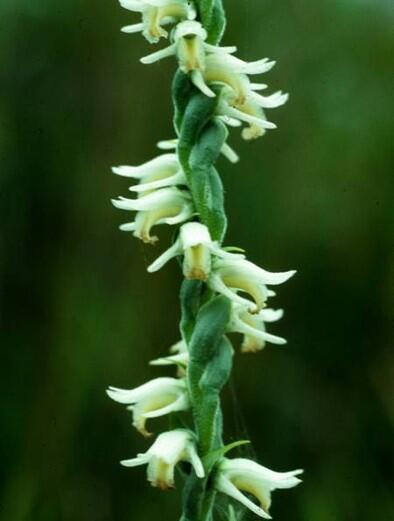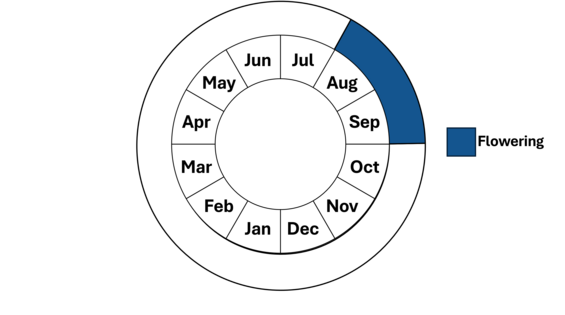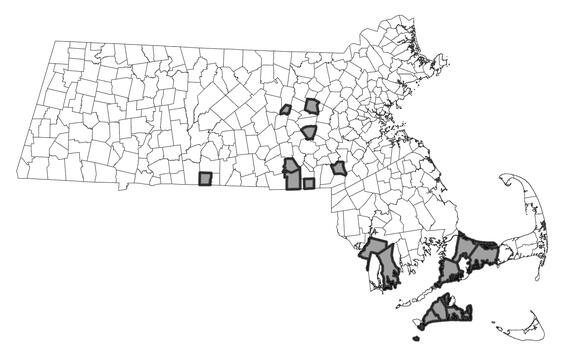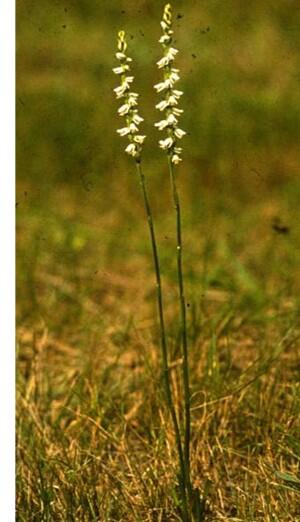- Scientific name: Spiranthes vernalis Engelm. & A. Gray
- Species of Greatest Conservation Need (MA State Wildlife Action Plan)
- Threatened (MA Endangered Species Act)
Description

Grass-leaved Ladies’-tresses: section of inflorescence showing spiral of flowers and yellow patch on the lip and plant in habitat. Photo: Bruce A. Sorrie, NHESP.
Grass-leaved ladies’-tresses (Spiranthes vernalis) is a slender, erect orchid of dry sandy habitats. It ranges from 20-80 cm (8-32 in) in height and has five to seven linear grass-like leaves grouped near the base of the stem. Up to 50 small whitish flowers are arranged in a single spiral that winds around the wand-like stem.
The single, pale green stalk may be hairless below but has numerous short, straight white “eglandular” hairs (i.e., without glands) throughout the axis of the inflorescence; these hairs are the most consistent character that differentiates grass-leaved ladies’-tresses from other ladies’-tresses (Spiranthes spp.). The five to seven basal leaves sheath the stem at the base, and resemble grass leaves, 5-25 cm (2-10 in) long and 4-12 mm (0.2-0.5 in) wide. The leaves are most visibly developed in May and June, often withering by flowering time in August. Leaves higher on the stem appear as closely appressed bracts. The small (6 mm; 0.2 in) white or cream-colored flowers are usually arranged in a spiral on the 3-15 cm (1.5-6 in) long spike (but occasionally are more densely arranged). The lip (lower petal) is oval-shaped and pubescent underneath, often with a faint yellow patch in the middle. Grass-leaved ladies’-tresses begins to bloom late July or early August, which is earlier than the five similar species noted below bloom.
There are several other ladies’-tresses that can occur in the same habitat, including a couple that are newly described based on DNA analysis (see Pace and Cameron 2017). Little ladies’-tresses (S. tuberosa), slender ladies’-tresses (S. lacera), nodding ladies’-tresses (S. cernua), Appalachian ladies’-tresses (S. arcisepala), and yellow ladies’-tresses (S. ochroleuca) are species that are similar to grass-leaved ladies’-tresses, and are known from the same region of the state and some similar habitats. Nodding ladies’-tresses (S. cernua) has larger flowers than grass-leaved ladies’-tresses (i.e., 1-2 cm; 0.4-0.8 in), which are densely arranged, often in three or four ranks (rather than in a spiral) along an axis covered in glandular hairs. Its labellum is essentially all white and the edge is crenulate and lacerate. Its lateral sepals are lanceolate. This species is more typically found in moister habitats than grass-leaved ladies’-tresses. Like the grass-leaved ladies’-tresses, the other four species of ladies’-tresses have a spiral inflorescence but differ in inflorescence axis pubescence and lower lip color. Little ladies’-tresses has a hairless axis and a pure white flower and is diminutive compared to grass-leaved ladies’-tresses. Its flowers are 4.5 mm (0.18 in.) long and smaller. Slender ladies’-tresses (S. lacera) has sparse glandular hairs along the axis and a green dot on the labellum lip. Its lateral sepals are held perpendicular to the stem, not at an oblique angle; it has no fragrance. The rachis of the inflorescence should be examined with a magnifying lens to differentiate among these species. The last two have labellums which have crenulate margins and are lacerate. Yellow ladies’-tresses (S.ochroleuca) is yellow on the underside of its labellum. Its lateral sepals sweep upward with their tips pointing to the upper petals and sepal. The Appalachian ladies’-tresses, (S. arcisepala) has 1-4 basal leaves held upright throughout flowering, then wither. Its lateral sepals are sickle-shaped and angled downward with their tips often surpassing the ruffled lower margin of the labellum. It is often found in damp to wet areas.
Life cycle and behavior

Another name for this orchid is spring ladies’-tresses as in the south, it blooms in the spring. In southeastern Massachusetts, it is the earliest ladies’-tresses to start blooming and is likely to start blooming at the end of July and continue through August. It produces grass-like leaves in the spring, but in Massachusetts those are not always retained until it blooms. The flowers produce nectar and attract bees for pollination, including Bombus impatiens and Apis mellifera. The seed capsules will open by slits in the fall and winter and the thousands of seeds will be scattered by wind.
Like all orchids, it is reliant on mycorrhizal fungi to support the initial development from seed and likely throughout its life. Ladies’-tresses orchids produce 6 or 7 tuberous roots. They are perennial but may not flower every year depending on the conditions.
Population status
Grass-leaved ladies’-tresses is listed under the Massachusetts Endangered Species Act as threatened. All listed species are protected from killing, collecting, possession, or sale and from activities that would destroy habitat and thus directly or indirectly cause mortality or disrupt critical behaviors. There are 27 populations that have been verified since 1999 in Barnstable, Bristol, Dukes, Middlesex, Norfolk, and Worcester Counties. Interestingly, it is not known from either Nantucket or Plymouth Counties. There are only 4 populations that are considered to be healthy enough to have a high likelihood of long-term survival.
Distribution and abundance
Grass-leaved ladies’-tresses is distributed from southern New England west to South Dakota, south to Florida and Texas. In Massachusetts, at the northern edge of its range, with few exceptions it is known from very small, scattered populations in the coastal plain. It is found more frequently and in larger populations in the little bluestem-dominated old fields of the extreme southern states. It is imperiled in Massachusetts and Rhode Island as well as in Delaware, Illinois, South Dakota and Nebraska. It is considered critically imperiled in Iowa, New York, and Pennsylvania. It is also found in Mexico, Central America and the West Indies.

Distribution in Massachusetts. 1999-2024. Based on records in the Natural Heritage Database.
Habitat

Photo: Bruce A. Sorrie, NHESP.
Grass-leaved ladies’-tresses occurs only in the eastern part of the state, primarily within the coastal plain region. It favors dry, sandy or gravelly soils and is found in open fields, sparsely vegetated grasslands, and open areas of pond shores. Like all orchids, this species lives in association with and is dependent on a root fungus in the soil which helps to provide necessary nutrients. It is often found in little bluestem (Schizachyrium scoparium)-dominated old fields maintained by periodic disturbance such as mowing or grazing. Co-occurring species include slender ladies’-tresses, Greene’s rush (Juncus greenei), Pennsylvania sedge (Carex pensylvanica), Virginia yellow flax (Linum virginianum), yellow wild indigo (Baptisia tinctoria), sweet fern (Comptonia peregrina), and lowbush blueberry (Vaccinium pallidum).
Healthy habitats are vital for supporting native wildlife and plants. Explore habitats and learn about conservation and restoration in Massachusetts.
Threats
Threats include loss of habitat due to development and succession from grassland to shrub cover due to suppression of natural disturbances or lack of management such as prescribed burns, mowing or grazing. Invasive plant species can also shade out this species if not controlled.
Conservation
Sites should be monitored for invasions of exotic plants and succession to shrubland; if exotic or native plants are crowding and out-competing this species, a plan should be developed, in consultation with MassWildlife’s Natural Heritage & Endangered Species Program, to remove the competitors. Rare plant locations that receive heavy recreational use should be carefully monitored for plant damage or soil disturbance; trails can sometimes be re-routed to protect population. All active management of rare plant populations (including invasive species removal) is subject to review under the Massachusetts Endangered Species Act and should be planned in close consultation with the Natural Heritage & Endangered Species Program. Research is needed into the mycorrhizae fungi that grass-leaved ladies’-tresses relies on, and whether there is only 1 or multiple species that it can use. It is important to know what the fungus uses, whether it relies on dead material or if it is associated with roots of living species in the sandplain grassland.
References
Pace, Matthew C. and Kenneth M. Cameron. 2017. The Systematics of the Spiranthes cernua Species Complex (Orchidaceae): Untangling the Gordian Knot. Systematic Botany 42(4). PP. 640-669.
Contact
| Date published: | May 8, 2025 |
|---|